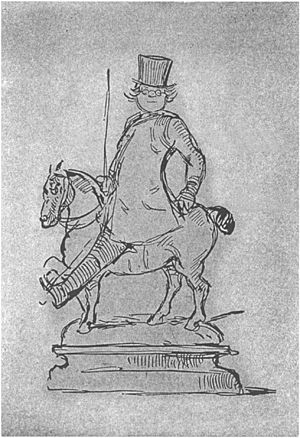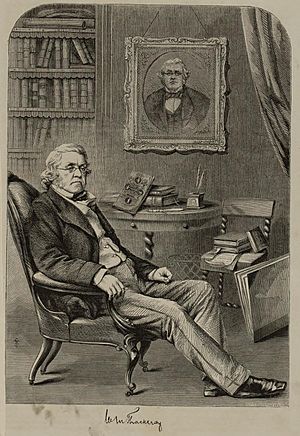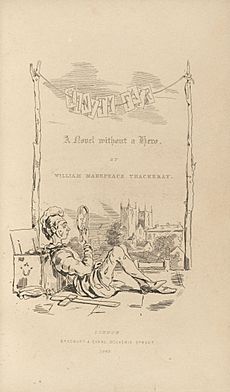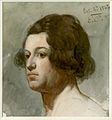William Makepeace Thackeray facts for kids
Quick facts for kids
William Makepeace Thackeray
|
|
|---|---|
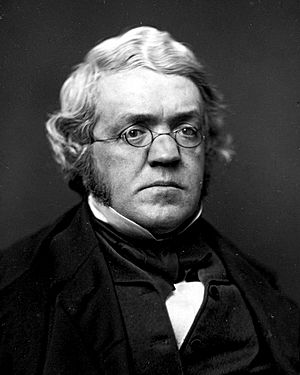
1855 daguerreotype of William Makepeace Thackeray by Jesse Harrison Whitehurst
|
|
| Born | 18 July 1811 Calcutta, British India |
| Died | 24 December 1863 (aged 52) London, England |
| Occupation |
|
| Nationality | English |
| Period | 1829–1863 |
| Genre | Historical fiction |
| Notable works | Vanity Fair, The Luck of Barry Lyndon |
| Spouse | Isabella Gethin Shawe |
| Children | 3; including Anne and Harriet |
| Signature | |
 |
|
William Makepeace Thackeray (born 18 July 1811 – died 24 December 1863) was a British writer and artist. He is famous for his funny and critical stories, especially his 1848 novel Vanity Fair. This book showed a wide picture of British society. Another well-known novel is The Luck of Barry Lyndon from 1844, which was later made into a movie by Stanley Kubrick.
Contents
About William Makepeace Thackeray
William Makepeace Thackeray was an only child. He was born in Calcutta, British India. His father, Richmond Thackeray, worked for the East India Company. His mother, Anne Becher, also came from a family connected to the East India Company.
William's father died in 1815. After this, his mother sent him to England that same year. On his journey, his ship stopped at Saint Helena. There, he saw the famous prisoner Napoleon.
Once in England, William went to different schools. He studied in Southampton and Chiswick. Then he went to Charterhouse School. He became good friends with John Leech there. William did not like Charterhouse much. He even made fun of it in his books, calling it "Slaughterhouse."
Even though he disliked the school, Charterhouse honored him after he died. He had a monument placed in the school's chapel. William became very tall, about six feet three inches. He started at Trinity College, Cambridge in 1829.
William was not very interested in schoolwork. He left Cambridge in 1830. But some of his first writings were published in university magazines. These were called The Snob and The Gownsman.
After Cambridge, William traveled in Europe. He visited Paris and Weimar, where he met the famous writer Johann Wolfgang von Goethe. He came back to England and started studying law. But he soon gave that up.
When he turned 21, William received money from his father's inheritance. However, he spent most of it quickly. He lost money gambling and by trying to start two newspapers that failed. He also lost money when two Indian banks collapsed.
With little money left, he needed a job. He first tried art and studied it in Paris. But he did not become a full-time artist. Later, he drew pictures for some of his own books.
William's life changed when he got married. On 20 August 1836, he married Isabella Gethin Shawe. They had three daughters. Their names were Anne Isabella, Jane (who died as a baby), and Harriet Marian. Harriet later married Sir Leslie Stephen, a famous writer and editor.
William started writing to support his family. He worked as a journalist. He wrote for Fraser's Magazine, which was a clever and sometimes harsh magazine. He wrote art reviews, short stories, and two longer stories: Catherine and The Luck of Barry Lyndon. From 1837 to 1840, he also reviewed books for The Times newspaper.
He also wrote for The Morning Chronicle and The Foreign Quarterly Review. Later, his friend John Leech helped him get a job at a new magazine called Punch. In Punch, he published The Snob Papers. These stories were later put together in a book called The Book of Snobs. This book helped make the word "snob" popular with its modern meaning. William wrote regularly for Punch from 1843 to 1854.
Sadly, William's wife, Isabella, became very ill after their third child was born in 1840. She needed special care for the rest of her life. William tried to find cures for her, but nothing worked. She lived for 30 years after William died. After his wife's illness, William was like a widower. He never married again.
In the early 1840s, William had some success with two travel books. These were The Paris Sketch Book and The Irish Sketch Book. The Irish book was not very kind to Irish Catholics. Because of this, Punch magazine made him their "Irish expert." He often wrote under the name Hibernis Hibernior, which means "more Irish than the Irish." William was responsible for Punch's very negative drawings and stories about the Irish during the Great Irish Famine (1845 to 1851).
William became more famous with his Snob Papers. But the book that truly made him a star was Vanity Fair. It started coming out in parts in January 1847. Even before Vanity Fair was finished, William was a celebrity. Important people, even those he made fun of, wanted to meet him. They said he was as good as Charles Dickens.
William stayed very popular for the rest of his life. He wrote several more big novels. These included Pendennis, The Newcomes, and The History of Henry Esmond. He also gave talks in London about English humorists and the first four kings from the House of Hanover. These talks were published as The Four Georges.
In 1857, William tried to become a member of Parliament for Oxford. He ran as a Liberal. He promised to support voting rights for more people. He was almost elected but lost by a small number of votes.
In 1860, William became the editor of a new magazine called Cornhill Magazine. But he did not like being an editor. He preferred to write a column for the magazine called "Roundabout Papers."
William's health got worse in the 1850s. He had a painful health problem that kept him in bed for days. He also felt he was losing his creative spark. He ate and drank too much and did not exercise enough. He enjoyed riding horses, though. Some people called him "the greatest literary glutton who ever lived."
On 23 December 1863, William had a stroke after dinner. He was found dead in his bed the next morning. He was 52 years old. His death surprised his family and friends. About 7,000 people went to his funeral. He was buried on 29 December at Kensal Green Cemetery. There is also a statue of him in Westminster Abbey.
Thackeray's Works
- The Yellowplush Papers (1837)
- Catherine (1839–1840)
- A Shabby Genteel Story (1840)
- The Paris Sketchbook (1840)
- Second Funeral of Napoleon (1841)
- The Irish Sketchbook (1842)
- The Luck of Barry Lyndon (1844)
- Notes of a Journey from Cornhill to Grand Cairo (1846)
- Mrs. Perkin's Ball (1846), under the name M. A. Titmarsh
- Stray Papers: Being Stories, Reviews, Verses, and Sketches (1821–1847)
- The Book of Snobs (1848)
- Vanity Fair (1848)
- Pendennis (1848–1850)
- Rebecca and Rowena (1850)
- Men's Wives (1852)
- The History of Henry Esmond (1852)
- The English Humorists of the Eighteenth Century (1853)
- The Newcomes (1855)
- The Rose and the Ring (1855)
- The Virginians (1857–1859)
- Lovel the Widower (1860)
- Four Georges (1860–1861)
- The Adventures of Philip (1862)
- Roundabout Papers (1863)
- Denis Duval (1864)
- Ballads (1869)
- Burlesques (1869)
- The Orphan of Pimlico (1876)
Thackeray started his writing career by writing satire. Satire is a way of using humor, irony, or exaggeration to criticize people's foolishness or problems in society. He also wrote parodies, which are funny imitations of other works. In his early works, he often used fake names like Charles James Yellowplush. He liked to make fun of high society, marriage, and people who were hypocrites (saying one thing but doing another).
One of his first works was "Timbuctoo" (1829). It was a funny take on a poetry contest at Cambridge. (The famous poet Tennyson won that contest). Thackeray's writing career really took off with The Yellowplush Papers. These stories appeared in Fraser's Magazine starting in 1837.
Between 1839 and 1840, Fraser's published Catherine. This book is sometimes seen as Thackeray's first novel. It was meant to make fun of crime stories. But it ended up being more of a picaresque tale. A picaresque story follows a clever but often dishonest hero on their adventures. He also started a novel called A Shabby Genteel Story, but he never finished it.
Along with The Luck of Barry Lyndon, Thackeray is probably most famous for Vanity Fair. This book shows how people try to get rich, powerful, and famous. It shows how people, especially the new middle class, try to act like the rich and powerful. In Vanity Fair, people often break moral rules to get what they want.
His other big novels written after Vanity Fair are not as well-known today. These include Pendennis, The Newcomes, and The Adventures of Philip. Pendennis is a Bildungsroman, which means it's a story about a character growing up and learning about the world. Arthur Pendennis is a character like Thackeray himself. The Newcomes looks at how people chose partners in marriage at the time. Philip tells parts of Thackeray's own early life.
Another important later novel is The History of Henry Esmond. In this book, Thackeray tried to write in the style of the 1700s. He loved that time period. Other books set in that time include Barry Lyndon and Catherine. The book The Virginians is a follow-up to Esmond. It takes place partly in North America and even features George Washington as a character.
Thackeray's Family
Parents
William's father, Richmond Thackeray, went to India in 1798 when he was 16. He worked for the East India Company. Richmond had a daughter named Sarah Redfield in 1804 with a woman named Charlotte Sophia Rudd. Both Charlotte and Sarah were mentioned in his will. It was common for gentlemen in the East India Company to have such relationships. This did not stop him from later marrying William's mother.
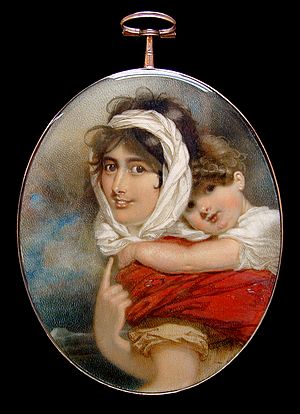
William's mother, Anne Becher, was born in 1792. She was known as a great beauty. Her father, John Harmon Becher, also worked for the East India Company. Anne, her sister Harriet, and their widowed mother were sent back to India in 1809. This happened because Anne's grandmother did not approve of the man Anne loved, Henry Carmichael-Smyth. Her grandmother told Anne that Henry had died, and told Henry that Anne was no longer interested. Neither of these things was true. Anne's grandmother wanted her to marry someone she thought was better.
Anne Becher and Richmond Thackeray married in Calcutta on 13 October 1810. Their only child, William, was born on 18 July 1811. There is a lovely small painting of Anne Becher Thackeray and William Makepeace Thackeray when he was about two years old. It was painted by George Chinnery around 1813.
In 1812, Anne's family's secret was found out. Richmond Thackeray invited the supposedly dead Henry Carmichael-Smyth to dinner without knowing. Five years later, after Richmond died in 1815, Anne married Henry Carmichael-Smyth in 1817. They moved to England in 1820. William had been sent to school in England more than three years before. Being separated from his mother at a young age affected William deeply. He wrote about it in his essay "On Letts's Diary."
Descendants
William Makepeace Thackeray has famous descendants today. These include the British comedian Al Murray and the author Joanna Nadin.
Thackeray's Legacy
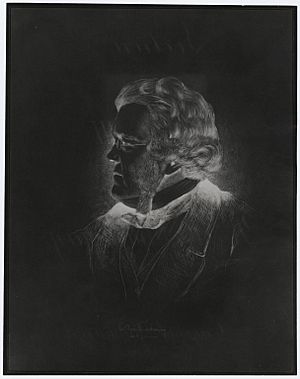
During the Victorian era, many people thought Thackeray was the second-best writer, after Charles Dickens. But today, fewer people read his books. He is mostly known for Vanity Fair. This book is often studied in universities. It has also been made into movies and TV shows many times.
Some people in Thackeray's time, like Anthony Trollope, thought The History of Henry Esmond was his best work. This might be because it showed values like duty and seriousness, which Victorians liked. Perhaps this is why his later novels are not as popular now as Vanity Fair, which made fun of those very values.
Thackeray saw himself as a "realist" writer. He felt his work was different from Dickens's, which he thought was sometimes too exaggerated or emotional. Some people agree with this idea. But others point out that Thackeray often used old-fashioned storytelling methods. For example, he would talk directly to the reader in his books. This sometimes broke the feeling that the story was real.
Charlotte Brontë, the author of Jane Eyre, dedicated the second edition of her famous novel to Thackeray.
In 1887, a special blue plaque was put on the house in London where Thackeray lived. This plaque remembers famous people and places. The house is now the location of the Israeli Embassy.
Thackeray's old home in Tunbridge Wells, Kent, is now a restaurant named after him.
List of Works
Series
Henry Esmond
- The History of Henry Esmond (1852)
- The Virginians (1857–1859)
Arthur Pendennis
- Pendennis (1848–1850)
- The Newcomes (1855)
- A Shabby Genteel Story (Unfinished) (1840)
- The Adventures of Philip (1862)
The Christmas Books of Mr M. A. Titmarsh Thackeray wrote and drew pictures for five Christmas books. He used the name "Mr M. A. Titmarsh."
- Mrs. Perkins's Ball (1846), as by M. A. Titmarsh
- Our Street
- Doctor Birch and His Young Friends
- The Kickleburys on the Rhine (Christmas 1850)
- The Rose and the Ring (Christmas 1854)
Novels
- Catherine (1839–40) (originally credited to "Ikey Solomons, Esq. Junior")
- The Luck of Barry Lyndon (1844)
- Vanity Fair (1847–53)
- Men's Wives (1852)
- Lovel the Widower
- Denis Duval (unfinished) (1864)
Novellas
- Elizabeth Brownbridge
- Sultan Stork
- Little Spitz
- The Yellowplush Papers (1837)
- The Professor
- Miss Löwe
- The Tremendous Adventures of Major Gahagan
- The Fatal Boots
- Cox’s Diary
- The Bedford-Row Conspiracy
- The History of Samuel Titmarsh and the Great Hoggarty Diamond
- The Fitz-Boodle Papers
- The Diary of C. Jeames de la Pluche, Esq. with his letters
- A Legend of the Rhine
- A Little Dinner at Timmins's
- Rebecca and Rowena (1850), a funny follow-up to Ivanhoe
- Bluebeard's Ghost
Sketches and Satires
- The Irish Sketchbook (2 Volumes) (1843)
- The Book of Snobs (1848), which made the word "snob" popular
- Flore et Zephyr
- Roundabout Papers
- Some Roundabout Papers
- Charles Dickens in France
- Character Sketches
- Sketches and Travels in London
- Mr. Brown's Letters
- The Proser
- Miscellanies
Play
- The Wolves and the Lamb
Travel Writing
- Notes of a Journey from Cornhill to Grand Cairo (1846), under the name Mr M. A. Titmarsh.
- The Paris Sketchbook (1840), featuring Roger Bontemps
- The Little Travels and Roadside Sketches (1840)
Other Non-Fiction
- The English Humorists of the 18th Century (1853)
- Four Georges (1860-1861)
- Roundabout Papers (1863)
- The Orphan of Pimlico (1876)
- Sketches and Travels in London
- Stray Papers: Being Stories, Reviews, Verses, and Sketches (1821-1847)
- Literary Essays
- The English Humorists of the 18th century: a series of lectures (1867)
- Ballads
- Miscellanies
- Stories
- Burlesques
- Character Sketches
- Critical Reviews
- Second Funeral of Napoleon
Poems
- The Pigtail
- The Mahogany Tree (1847)
See also
 In Spanish: William Makepeace Thackeray para niños
In Spanish: William Makepeace Thackeray para niños
- Barry Lyndon, the 1975 film based on his novel by Stanley Kubrick
Images for kids
-
1855 daguerreotype of William Makepeace Thackeray by Jesse Harrison Whitehurst
-
Anne Becher and William Makepeace Thackeray by George Chinnery, c. 1813
-
Etching of Thackeray, ca. 1867


